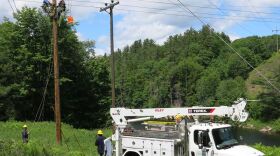Niagara Falls, 1911. Completely frozen over with a group of people standing where they would otherwise be sucked into the rushing waterfall. Incredible? Absolutely! Totally truthful? Not exactly.
Hoax. Prank. Practical joke. Trick. Different names with varying degrees of severity or deception, but they all share one thing in common: intent to make people believe something that is not real. Ipso facto non-existo. To create a viable and enduring fake viral image, a certain amount of finesse is required to invoke a sense of just the right amount of authenticity. Otherwise, images or stories are much more easily and quickly dismissed. A balance of the natural and fantastical can produce the most enduring fake viral images, leaving room for the believers to share!share!share! and the nonbelievers to continue making sure the whole Internet knows just how obviously Photoshopped that image is, you guys! And Paleofuture is all about calling out those fake photos. Is your spidey sense tingling? Check out this altered photo of a wolf spider. Yes, they exist. No, they do not have a six foot leg span.

While a lot of viral images embellish natural landscapes, flora, and fauna, many are altered photos of people. And (keep in mind when posting selfies or other photos intended for social media- even Snapchat) all internet photos of people are open to retouching, from the plebes to the celebs. A major difference for these photos is that people often know they are being duped, almost expect it. Does Jennifer Lawrence really look like this? No. We know it. She knows it. And it has become advertising and media canon.

It's hard not to be skeptical every time you open a browser knowing that a lot of what you see and read could be totally fake. Those who are naturally skeptical find themselves sucked into vortexes of non-believeing, and those who look up when someone says "Gullible is written on the ceiling!" can find themselves feeling duped and untrusting. Worse yet, people can perpetuate the hoaxes until they become internet canon, like they are inducted into the archive of "I saw it on the internet, so it must be real." - A problem one particular State Farm commercial laughed at in a 2012. Though not a hoax, it does involve internet deception from a, ahem, French model.
So. Take care, internet consumers. Not everything you see online is always 100% totally real and authentic. But that doesn't mean it can't be awesome.

To hear more about the creation of viral images, listen to Virginia Prescott's conversation with Matt Novak of Paleofuture.







